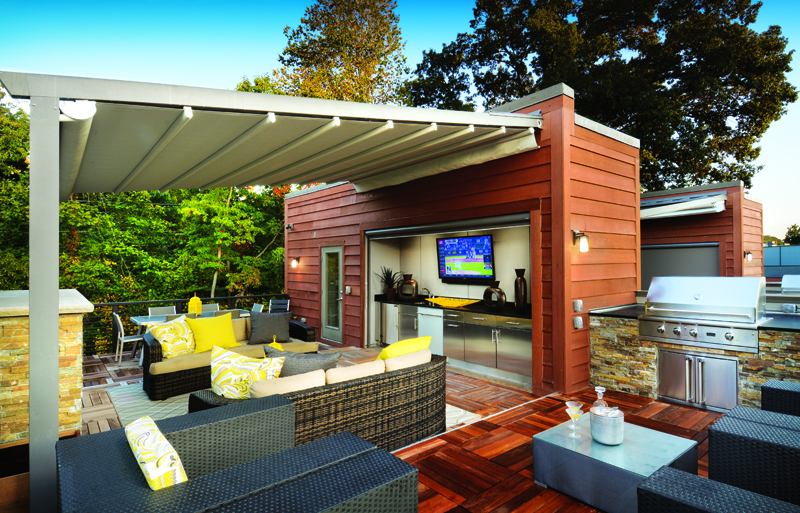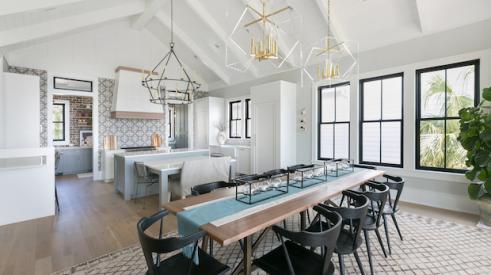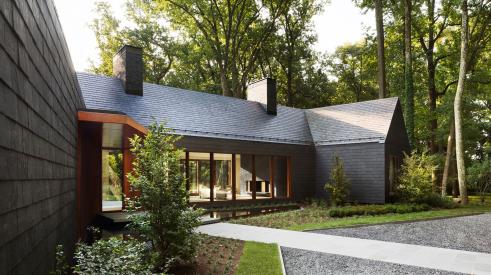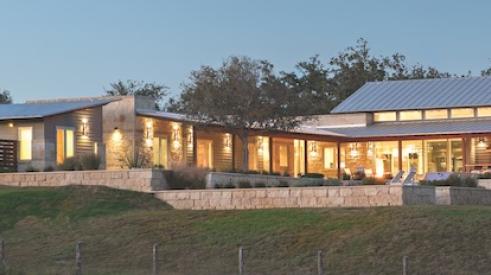It’s been noted more than once that urban infill housing is a positive, growing trend. And industry professionals seem confident that, for the time being at least, there are plenty of developable sites to go around.
With the aging of housing stock and commercial real estate in America’s cities, civic leaders are studying ways to revitalize their downtowns. It’s to the benefit of home builders, designers, land planners, and city officials—not to mention neighborhood residents and potential buyers—to collaborate on those solutions.
City View Over Tree Tops Infill Development
“Life within walking distance” is the motto of Bethesda, Md.-based builder/developer EYA. The company is adept at finding infill locations that make transportation, services, and amenities reachable on foot.
Little Falls Place is 2 miles from downtown Bethesda with its shops and restaurants; less than a mile from public transportation; and within walking distance of a Whole Foods supermarket. The 2-acre site is surrounded by parkland and has direct access to the Capital Crescent Trail, which stretches all the way to the Georgetown waterfront. Specially designed bike paths guide residents to the trail.
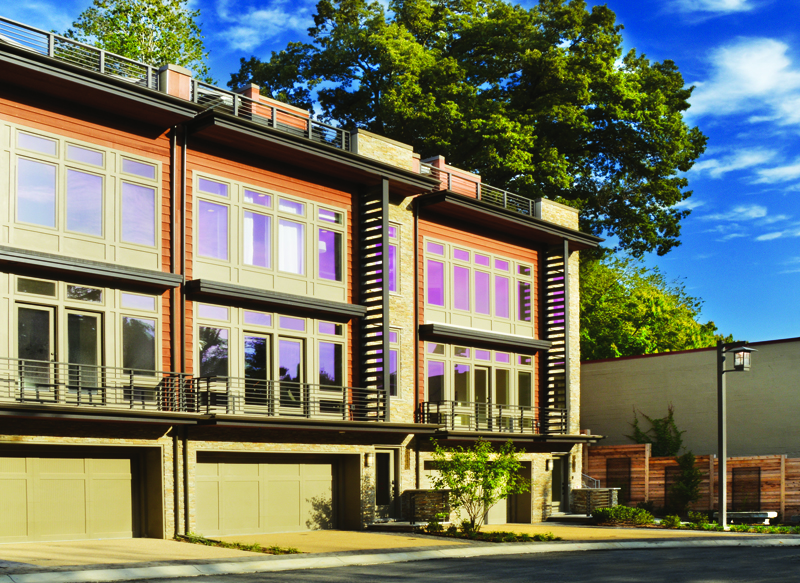
To integrate Little Falls Place with its bucolic surroundings, EYA used elements of mid-century modern and Prairie style architecture, exemplified by large walls of glass, natural stone, and cedar siding. Photo: Thomas Arledge
“It’s so close to everything, yet it feels secluded and away from it all,” says Preston Innerst, vice president of sales and marketing for EYA. The company demolished an existing concrete-block manufacturing plant on the site, while Lessard Design, of Vienna, Va., created a new land plan that conserves approximately half an acre as green space.
Jack McLaurin, a former Lessard associate who is now vice president of planning and design for EYA, developed 30 townhomes with an eye toward something organic that would bring the outdoors in.
“We knew we had a three-story height limit, whereas EYA is typically into four-story townhomes or row homes,” McLaurin says. “Because of that, we decided to go to 24-foot-wide homes. And the bucolic surroundings really called for front-loaded garages, where normally we would do rear-loaded garages.”
Two predominant buyer types were identified for Little Falls Place: empty nesters downsizing from larger single-family homes and move-up professionals coming out of smaller condominiums. “The common thread is that they’re both looking for the lock-and-leave lifestyle—in other words, low maintenance,” Innerst says.
The 2,430-square-foot homes have three bedrooms and 2 ½ baths. In addition, they offer 1,130 to 1,325 square feet of exterior space, including a private rear yard, recreation rooms, and two-car garages. One floor plan includes a library.
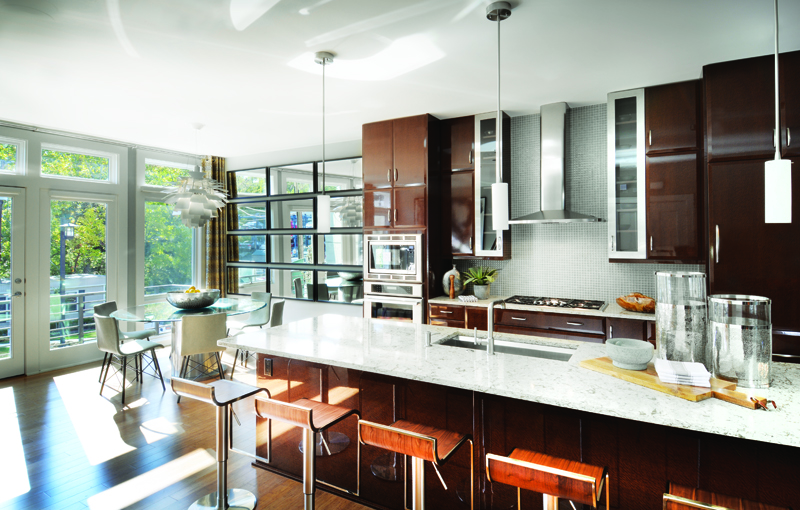
Kitchens have spacious islands and features such as frameless cabinetry; quartz countertops; stainless steel, five-burner cooktops; built-in convection ovens and microwaves; and two-drawer, bottom-freezer refrigerators with matching cabinetry panels. Photo: Thomas Arledge
Kitchens have very generously sized islands, which is highly unusual in townhomes, McLaurin says. Taller ceilings (9 ½ feet) and floor-to-ceiling windows and glass doors flood the interiors with light.
The contemporary architecture has elements of mid-century modern and Prairie style. The natural stone veneer is mortar-applied, with cedar siding as the other dominant material.
The initial product release did not include elevators—an omission that EYA quickly rectified. Sales have been strong ever since, with 25 of 30 homes sold since last September at a starting price of $1.5 million. Elevator townhomes are available elsewhere in the Bethesda market, but the rooftop terraces at Little Falls Place, Innerst says, are unique—800 square feet and available with retractable awnings, gas fireplaces, outdoor kitchens, TV sets, and wet bars. “We’re surrounded by parkland, so the views are amazing,” he adds.
Infill Housing That Offers a Rare Rental Opportunity
Element 47 in Denver has been a hit with Millennials who want to live near sports venues, microbrew pubs, restaurants, and other attractions. The community is just east of Jefferson Park, in the middle of a quiet residential area.
“We’re fortunate in that the project sits maybe 40 feet above the interstate, so you look over it rather than right at it,” says John Binder, KEPHART principal and project manager.
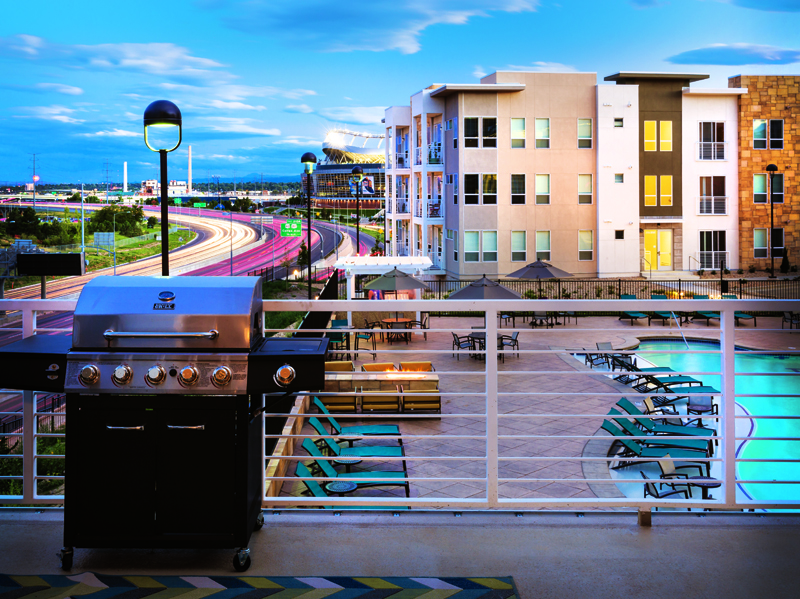
Element 47 is on a hilly site adjacent to downtown Denver and 40 feet above a busy interstate. Part of its appeal is that Sports Authority Field, where the Broncos play, is nearby, as well as baseball, basketball, and hockey venues. Photo: Steve Hinds.
Builder/developer A.G. Spanos Cos., headquartered in Stockton, Calif., worked its way through a difficult entitlement process that took two years. The project was initially entitled for 350 units, but Spanos decided to redesign it at a lower density to better accommodate the site’s unique challenges.
Binder says that the original numbers didn’t work because of the amount of below-grade parking needed to support the hilly site. “We went back through the review process and the neighborhood meetings to approve a lower-density product—265 units,” he says. “The buildings went from four stories to three. Now the density is 41.3 units per acre, and we have a 1.65:1 ratio of parking spaces to apartments.”
Element 47 includes 15 two-story live/work apartments and 4,000 square feet of street-level, boutique retail space. The on-site amenities include a clubhouse, yoga and fitness studios, a movie theater, a cyber café, and a rooftop deck with an outdoor fireplace and city views.
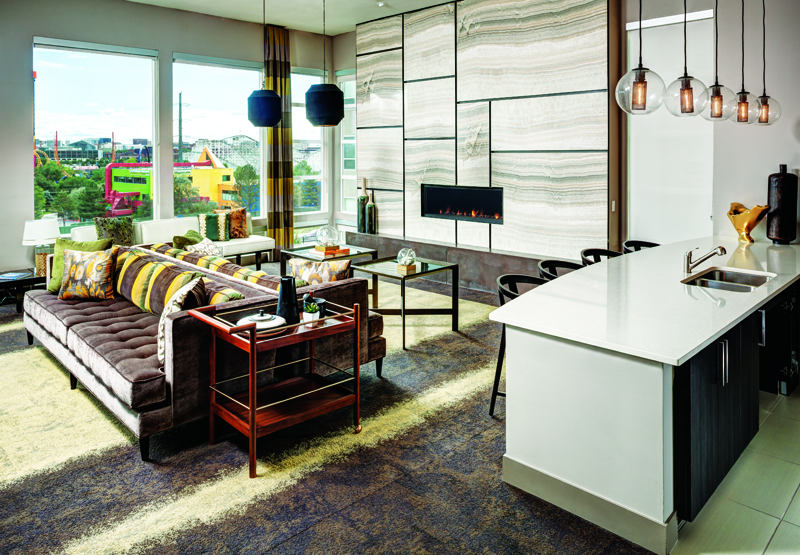
Millennials have been leasing apartments at Element 47 in droves, partly because there are so many amenities close by, but also due to the sleek, modern interiors. Photo: Steve Hinds
The apartments range from 580 to 1,100 square feet. Some of the larger units have two master bedrooms. To date, 59 apartments are leased, including 12 live/work units. “The lease-up has been fantastic, with almost record numbers,” says Alexandros “Lex” Economou, regional vice president for Spanos.
Economou notes that the upcoming generation of renters seems to favor living close to the city. “They don’t want to spend their young lives in cars. So a lot of what we’re looking for now in sites is proximity to amenities like retail and jobs, and you can find those little pockets in a lot of places.”
New rental projects under way in Denver tend to be mid-rise or high-rise buildings. Element 47 stands out because it’s a low-rise project near downtown, but in a classic infill neighborhood on a park.
Anaheim’s Revival Continues and Attracts a Range of Buyers
What started as a redevelopment agency project on land owned by the city of Anaheim, Calif., is now The Domain, a mix of townhomes and stacked flats that is attracting a diverse group of buyers.
The city has been revitalizing its downtown for decades, notes John Woodhead, director of community and economic development. “In the last 10 years, we’ve been able to develop about 1,500 new residences in downtown Anaheim,” he says.
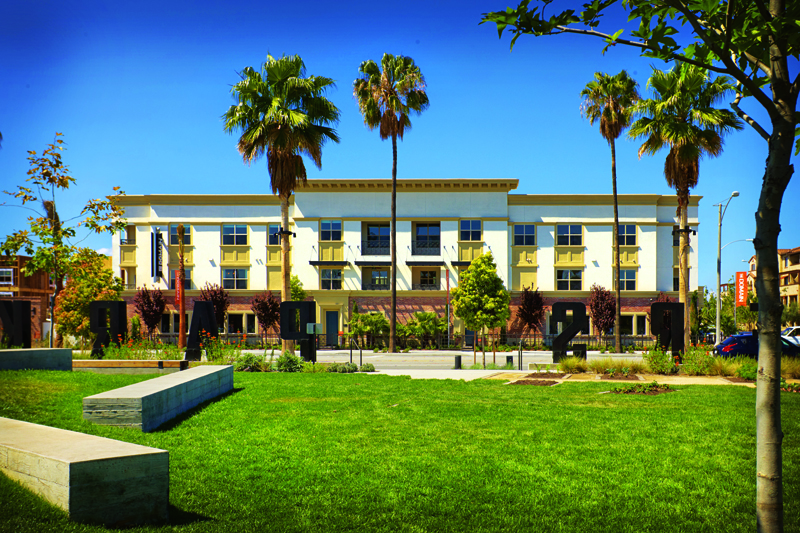
According to John O'Brien of Brookfield Residential, The Domain's exterior architecture is "masculine and civic-looking" in keeping with early 20th-century Anaheim buildings.
A restored 1919 packing house opened last May as a food hall in the style of Seattle’s Pike Place and San Francisco’s Ferry Building. The Packing House and adjacent farmers market are popular destinations that just happen to be across the street from The Domain.
“At the time we got involved, [the Domain site] was occupied by an old warehouse,” says John O’Brien, vice president of Brookfield Residential’s Southern California division in Costa Mesa, Calif. “Down the street was a dry-cleaning business with some underground plume that drifted back under our property.” A vapor barrier underneath the slabs prevents transmission of soil gases into the buildings.
Designed by Robert Hidey Architects, in Irvine, Calif., The Domain’s four U-shaped three-story buildings comprise 100 units. Hidey created 10 distinct floor plans dispersed over two floors above parking. Homes range from 746 to 1,644 square feet and are priced from the mid $300,000s to the high $400,000s. The overall project density is 24.3 DUA. To date, about half of the units are sold. Buyers include single women, dual-income married couples with no children, and empty nesters. It’s a blend of the hipster, younger crowd and movedowns who are done with maintenance and crave the lock-and-leave lifestyle as well as walkability, O’Brien says.
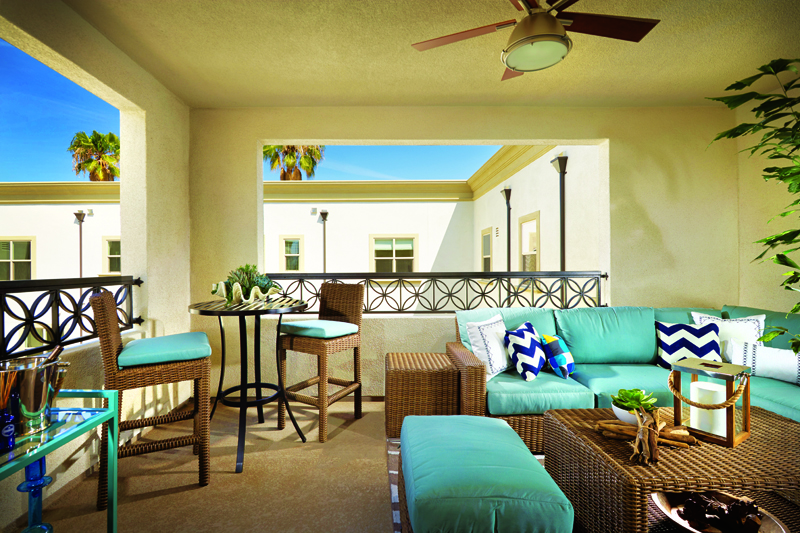
Large furnishable balconies are perfect for entertaining and provide an extension of indoor living space.
Hidey says that The Domain’s exterior styling is derived from Anaheim’s early 20th-century architecture: “The aesthetic utilizes straightforward stacking windows organizing the exterior wall, with materials that are generally found in the region.” A preponderance of brick ensures compatibility with Anaheim’s remaining historic sites.
The local historical society provided old photos for an image board that became a jumping-off point for “a masculine, civic-looking architecture that is really kind of the gentleman on the block for residential living,” O’Brien says.
Homeowners park in street-level garages that are accessible via a private city lane into a secluded auto court. Homes above are connected by a shared lobby with an elevator, while two-story units have been positioned to give private front-door access at the street level.
New Homes Spark Old Norristown
At press time, framing had just begun at Arbor Mews in Norristown, Pa. But two of the 28 townhomes have already been sold and a third agreement signed on the strength of high-quality virtual tours and local buzz for Arbor Heights, the project’s first cousin a couple of blocks away.
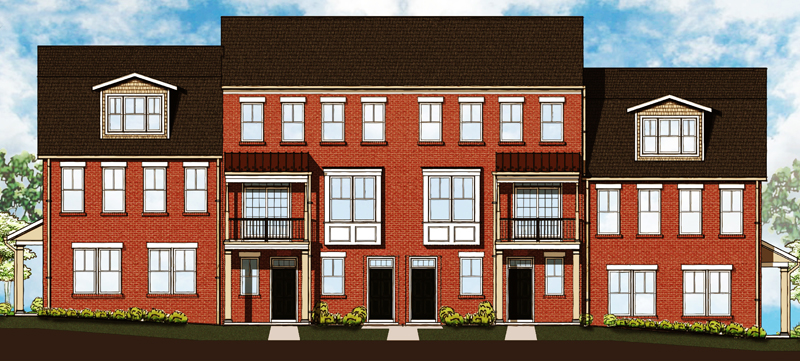
Brick siding on the front elevation evokes the area's historic mansions. Ten-inch round corinthian columns on the first level and chamfered columns on the upper level are in keeping with the Norristown style.
A little more than four years ago, builder/developer Progressive Housing Ventures, in Malvern, Pa., proved that new residential construction in Norristown’s historic district could succeed. After first-time buyers snatched up the 12 townhomes at Arbor Heights, built on a blighted city block, the neighborhood started to turn around. Now Progressive Housing’s owner and founder, Sarah Peck, is back with new designs and financing assistance for buyers.
Arbor Mews consists of back-to-back and piggyback townhomes designed by Norristown architect Greg Wissman. “This product type works really well for Norristown,” he says, “... an old mill town with rear alleys and front doors on the street."
They have garages and are a bit more conventional-looking than the Arbor Heights product, Peck says. “The price point [starting in the $140,000s] is really attractive, and I was successful in securing public funds to help write down the cost of the project.”
Homes are grouped in three buildings of eight units each that face the existing streets in a U-shape. Every unit has an attached, rear-loaded garage, its own front door, and a porch or balcony. Floor plans range from 1,100 to 1,722 square feet with two to three bedrooms and 1 ½ to 2 ½ baths. One plan has a first-floor study.
The homes are designed in 23-foot modules, with two levels of living space above a one- or two-car garage. The living room and dining room stretch across the full 23 feet and have large windows that admit daylight throughout the home.
Peck and Wissman worked with the historical commission to evoke the flavor of the area’s grand brick-and-masonry mansions. “The commission strongly suggested that we keep the massing of the buildings and not have elevation changes,” Wissman says.
Arbor Mews is walkable to a variety of public transportation options as well as to government and medical offices, hospitals, shopping, restaurants, and recreational opportunities.
Advertisement
Related Stories
Traditional Architecture With A Twist
Historic house shapes merged with modern features satisfy a variety of client wish lists while making neighbors happy
Dark Materials Tell the Story of This Home's Past
This house memorializes the owners’ previous abode, which had been destroyed by an electrical fire
Three Custom Homes Honored by Best in American Living Awards
These three custom homes stood out in the Best in American Living Awards for their site sensitivity and attention to detail


